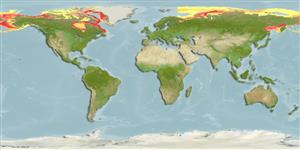Environment: milieu / climate zone / depth range / distribution range
Écologie
marin; saumâtre démersal; profondeur 0 - 632 m (Ref. 117245). Polar; 83°N - 51°N, 33°E - 45°W (Ref. 117245)
Arctic to Northwest Atlantic and Northwest to Northeast Pacific: Hudson Bay and Labrador in Canada and Greenland. Also in the Barents Sea, Kara Sea, White Sea and Siberia (Ref. 4700); Chukchi Sea, Bering Strait, Bering Sea and Anadyr Gulf (Ref. 6876).
Taille / Poids / Âge
Maturity: Lm ? range ? - ? cm
Max length : 8.6 cm TL mâle / non sexé; (Ref. 4700)
Épines dorsales (Total): 0; Rayons mous dorsaux (Total): 5-7; Épines anales 0; Rayons mous anaux: 5 - 7. Caudal fin rounded. Upper parts brownish-grey, with a few dark spots or bands, lower parts light (Ref. 4700).
Found on sand and mud bottoms, at temperatures mostly below 0°C, rarely to 2-3°C or more and salinities of 33-35 ppt (Ref. 4700). Benthic (Ref. 58426). Minimum depth reported at 7m (Ref. 5951). Feeds on small amphipods, ostracods and nemertine worms (Ref. 4700).
Life cycle and mating behavior
Maturité | Reproduction | Frai | Œufs | Fécondité | Larves
Andriashev, A.P., 1986. Agonidae. p. 1265-1268. In P.J.P. Whitehead, M.-L. Bauchot, J.-C. Hureau, J. Nielsen and E. Tortonese (eds.) Fishes of the North-eastern Atlantic and the Mediterranean. volume 3. UNESCO, Paris. (Ref. 4700)
Statut dans la liste rouge de l'IUCN (Ref. 130435)
Menace pour l'homme
Harmless
Utilisations par l'homme
Plus d'informations
RéférencesAquacultureProfil d'aquacultureSouchesGénétiqueElectrophoresesHéritabilitéPathologiesTraitementNutrientsMass conversion
CollaborateursImagesStamps, Coins Misc.SonsCiguateraVitesseType de nageSurface branchialeOtolithesCerveauxVision
Outils
Articles particuliers
Télécharger en XML
Sources Internet
Estimates based on models
Preferred temperature (Ref.
123201): -1.6 - 1.8, mean -0.6 °C (based on 1824 cells).
Phylogenetic diversity index (Ref.
82804): PD
50 = 0.7500 [Uniqueness, from 0.5 = low to 2.0 = high].
Bayesian length-weight: a=0.00363 (0.00161 - 0.00818), b=3.18 (2.97 - 3.39), in cm total length, based on LWR estimates for this species & (Sub)family-body (Ref.
93245).
Niveau trophique (Ref.
69278): 3.3 ±0.5 se; based on diet studies.
Résilience (Ref.
120179): Milieu, temps minimum de doublement de population : 1,4 à 4,4 années (Assuming tm=2-4;Fec<2000).
Fishing Vulnerability (Ref.
59153): Low vulnerability (10 of 100).
